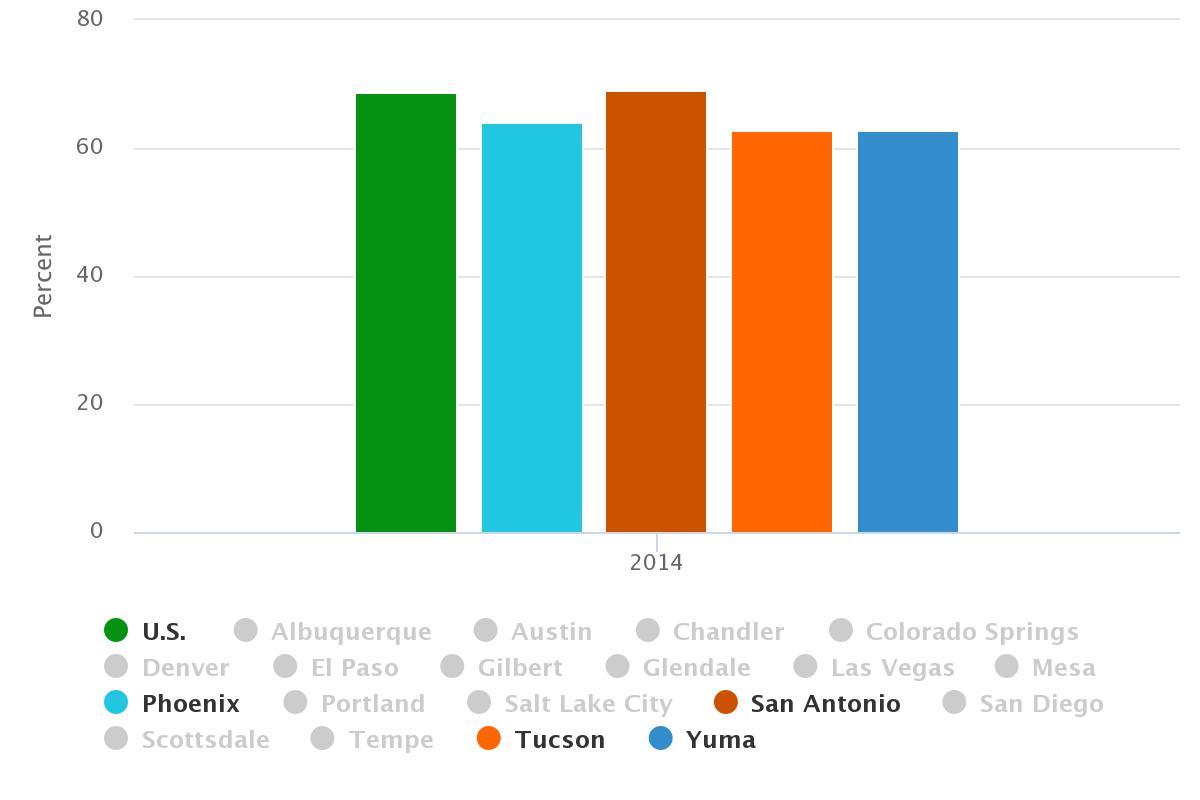Tucsonans engaged in more leisure-time physical activity than the average U.S. resident, according to data from the 500 Cities Project. This report focuses on city-level data, which differs from the county-level aggregations that make up Metropolitan Statistical Area (MSA) data found in many other studies and elsewhere on the MAP Dashboard.
In 2014, 22.6% of adults aged 18 years and older living in Tucson reported no leisure-time physical activity during a 30 day period. That was almost a full percentage point lower than the U.S. and nearly seven percentage points lower than San Antonio. Scottsdale reported the lowest percentage of those with no leisure-time physical activity at 14.6%. It is well known that regular physical activity can improve one’s quality of life, while reducing the prevalence of disease. The U.S. Department of Health and Human Services 2008 Physical Activity Guidelines for Americans suggest that some physical activity is better than none and that adults who participate in any amount of physical activity gain some health benefits. Figure 1 shows survey results across select western cities. Note that a shorter bar on the graph is good, because it indicates more leisure-related physical activity.
Figure 1: No Leisure-Time Physical Activity Among Adults

The 500 Cities Project reports city and census tract data for measures in three categories: Unhealthy Behaviors, Health Outcomes, and Prevention. Unhealthy Behaviors include measures such as binge drinking, smoking, obesity, and no leisure-time physical activity. Health Outcomes include measures such as arthritis, high cholesterol, coronary heart disease, mental health not good for 14 days or more, physical health not good for 14 days or more, and stroke. Prevention includes interventions that may prevent, identify, or delay the occurrence of disease. Prevention indicators include measures such as routine doctor or dental visits, cholesterol screening, mammography use, and health insurance rates.
Poor mental and physical health influence a person’s quality of life and are risk factors for other chronic diseases. Tucson ranked last in the percentage of adults who report 14 or more days of poor mental health, at 13.3%. Figure 2 highlights the results for select western cities. Note that Scottsdale performed best.
Figure 2: Mental Health not Good for 14 Days or More During a 30 Day Period for Adults

Tucson does slightly better in physical health relative to select western cities, with 13.8% of adults reporting poor physical health. As Figure 3 shows, Tucson was tied with Phoenix and El Paso but ahead of Yuma.
Figure 3: Physical Health Not Good for 14 Days or More During a 30 Day Period for Adults

Access to healthcare services, such as annual doctor visits, are a vital component of preventative services. Regular doctor visits can help identify risk factors and health problems, thus reducing morbidity and mortality from chronic diseases. San Antonio reported the highest percentage of adults who routinely visit the doctor at 69.2% followed closely by the national rate of 68.7%. As Figure 4 shows, Tucson’s rate was 62.9%, which fell in the bottom half among select western cities.
Figure 4: Annual Visit to a Doctor for Routine Checkup Among Adults

The Robert Wood Johnson Foundation in partnership with the Centers for Disease Control (CDC) launched the 500 Cities Project to report city and census tract-level data for 27 chronic disease measures. To learn more view the full 500 Cities Report at www.cdc.gov/500cities.













